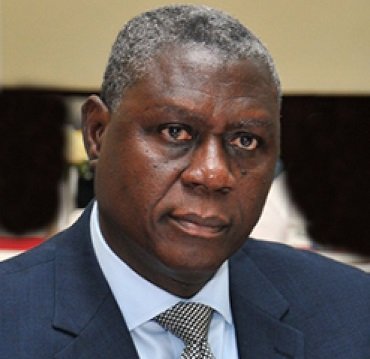Features
‘Peeping’ into the ‘thoughts’ of the Chief Justice

Just last week, the Chief Justice, Mr Kwasi Anin-Yeboah, made ‘landmark statements’ about the media in Accra.
Reportedly, he said : “The judiciary has no power or option of interfering with media freedom”, stressing that “Ghana must and will remain a bastion of freedom of speech.”
The caveat of the Chief Justice was, however; “we must urgently address the issues of standards and propriety in relation to court reporting, else we make ourselves vulnerable to misinformation that will mislead the citizenry.”

Chief Justice
GJA President
Justice Anin-Yeboah made these statements while inaugurating the Judicial Press Corps , besides launching a handbook for journalists on court reporting.
The Chief Justice added:”The media is not an enemy of the judiciary, rather the two entities are enjoined by the Constitution to fight for peace and development of Ghana.”
However, he cautioned media practitioners and other communicators to respect the sanctity of the law courts and assured that the courts will do their best to ensure the smooth operations of the media.
The fact of the matter is that none of the arms of government has any power or option , under our 4th Republican Constitution , to interfere with media freedom, free expression and freedom of speech.
Indeed, freedom of speech and expression is the lifeblood of any democracy. For instance, to debate and vote, to assemble and protest, to worship, to ensure Justice for all; all these rely upon unrestricted flow of speech and information.
Really, democracy is communication: people talking to one another about their common problems and forging a common destiny. And before people can govern themselves, they must be free to express themselves.
This column, however, whole-heartedly agrees with the Chief Justice that , “we must urgently address the issues of standards and propriety”, not only in relation to court reporting but also “high media standards” in all spheres of our media industry.
As modern societies grow in size and complexity, the arena for communication and public debate is increasingly dominated by the news media and this time round, the social media.
The news media in a democracy have a number of overlapping functions . One is to inform and educate.
A second function of the media is to serve as a watchdog over government and other powerful institutions in the society, including the judiciary.
By holding to a standard of independence, objectivity and fairness; however imperfectly, the news media can expose the truth behind claims of governments and hold public officials accountable for their actions.
If they choose, the media can also take a more active role in public debates. For instance, through editorials or investigative reporting, the media can campaign for specific policies or reforms that they feel should be enacted.
Analysts point to another important role of the media: “setting the agenda”. Since they cannot report everything, the news media choose which issues to report and which issues to ignore.
In effect, the news media decide what is news and what is not news. Such decisions, in turn, influence the public’s perception of what issues are most important.
Readers, not many people, including our Chief Justice, may argue that the news media always carry out their functions responsibly.
Many journalists, who are “messengers of news” , may also aspire to high standards of objectivity and fairness, but the fact of the matter is that, in some cases, news is inevitably filtered through the biases and sensibilities of individuals and the enterprises for which they work.
The reality on the ground is that, news can be sensational, superficial, intrusive, inaccurate and inflammatory.
And the question is: what should institutions of state do in cases where the news media or other organisations abuse freedom of speech; with information that in the opinion of the majority, is false, repugnant, irresponsible or simply, in bad taste?
It may seem a paradox but some advocates of free speech claim that the solution is not to devise laws that set arbitrary definition of responsibility or to license journalists, but to broaden the level of public discourse so that citizens can better sift through the chaff of misinformation and rhetoric to find the kernels of truth.
Indeed, the “supersonic change of the world” is revealing but in 1919 a distinguished Justice of the Supreme Court of the United States of America, Oliver Wendel Holmes stated: “The best test of truth is the power of the thought to get itself accepted in the competition of the market.”
An American essayist, E.B White, puts it this way:”The press in our free country is reliable and useful not because of its good character but because of its great diversity.
“As long as there are many owners, each persuing its own brand of truth, we the people, have the opportunity to arrive at the truth and dwell in the light.”
So, My Lord Chief Justice, as you rightly stated; the media is not an enemy of the judiciary, the two entities are enjoined by the Constitution to fight for peace and development of our country.
The only snag here, in my view, is that the seemingly ‘germinating’ social media ‘terrorism’ in the country should not ‘infuriate’ the judiciary to sew “terrorism gowns and wigs” to counterbalance the irresponsibility of the new phenomenon where fake news is on “unstoppable” ascendancy.
Contact email/ WhatsApp of author:
asmahfrankg@gmail.com (0505556179)
———END——-
Features
Who knows tomorrow?
Recently a friend posted a sad news on his Facebook page, announcing the death of a school mate who had passed away, suddenly. The report had it that he was on his way to the airport to take a flight to Ghana.
I am sure this man had already informed the wife or a friend or a work colleague at work that he was returning home but he was not to return as a human being but as a dead body.
Such is life and so we need to be circumspect in how we go about things in life. The Bible reminds us that we are like grass which at one point in time looks elegant and the next moment becomes withered according to Psalm 90:5 and 6. It is for this reason that we need to guard our hearts with the word of God so that we shall be motivated to do the right thing, at all times.
This will enable us live on this planet, free from all sorts of troubles in our personal lives, even if we ignore the question of Heaven and Hell. Living a disciplined life delivers us from any kind of trouble as the Bible declares in Galatians 5:23 that against such there is no law.
The uncertainty surrounding our lives on earth is the more reason why people should commit their lives into the hands of the one who created it, in the first place unless you believe that the world created itself and that it appeared from nowhere.
Otherwise, the logical thing to do is to recognize the authority of the creator and surrender to his Lordship. Heaven is real and Hell is real, so for us who know the truth and have received Jesus as our Lord and Saviour, the onus lies on us to encourage our relations who have not believed and received Jesus into their lives, to do so.
We are a couple of days from another Easter Resurrection celebration and an opportunity to reflect on our lives in relation to the significance of Easter. In the Bible, the only occasion Jesus, Saviour of the world commands us to celebrate is his death and resurrection.
He never commanded his followers to celebrate his birth but like everything else, we chose to ignore Jesus’s instructions and decided to do what pleases us, just like our forefather and mother in the Garden of Eden.
Let us deliberately choose to do things differently as Christians this Easter, so we can really benefit from all the blessings that the celebration of the death and birth of Jesus, has on offer. Doing the same thing over and over and expecting a different result is definitely insanity.
I choose to be different this Easter and I am believing God for a newness of life so God’s glory would be revealed in me to draw the unsaved to him. It is only when people especially the unsaved, see the character of Christ in us, that they can be convinced about the authenticity of Jesus, as Saviour of the world, who can bring transformation in their lives too.
This is what would motivate them to surrender their lives to Jesus Christ. Let us make this Easter a memorable one that will be cherished for a long time. It is also a period for reconciliation and it would be great if in the spirit of Easter, we would try to reach out to those who have wronged us or have a grudge against us.
This would demonstrate that we have indeed accepted Jesus and that our religious posture is not a sham. May the good Lord grant us the grace to love our neighbours as ourselves, demonstrating the love of God in the process.
Those who have lost their loved ones and Easter brings sad memories, may the good Lord comfort and strengthen you. God bless.
.NB: ‘CHANGE KOTOKA INTERNATIONAL AIRPORT TO KOFI BAAKO INTERNATIONAL AIRPORT’
Features
Cosmetic deformities
COSMETIC deformities refer to physical imperfections or abnormalities that affect an individual’s appearance, often causing emotional distress and impacting their quality of life.
These deformities can be congenital, acquired, or result from various medical conditions or treatments. This article provides an in-depth exploration of cosmetic deformities, their types, causes, effects, and treatment options.
Types of cosmetic deformities
Cosmetic deformities can affect various parts of the body, including the face, skin, hair, nails, and teeth. Some common types of cosmetic deformities include:
1. Facial deformities: Congenital or acquired abnormalities affecting the shape, structure, or appearance of the face, such as cleft lip and palate, facial paralysis, or facial asymmetry.
2. Skin deformities: Conditions affecting the skin’s texture, tone, or appearance, such as acne, scars, birthmarks, or skin discoloration.
3. Hair deformities: Abnormalities affecting the hair’s growth, texture, or appearance, such as alopecia, hirsutism, or hair loss due to medical conditions or treatments.
4. Nail deformities: Conditions affecting the shape, size, or appearance of the nails, such as nail fungus, nail psoriasis, or nail trauma.
5. Dental deformities: Abnormalities affecting the shape, size, or appearance of the teeth, such as tooth decay, tooth loss, or malocclusion.
Causes of cosmetic deformities
Cosmetic deformities can result from various factors, including:
1. Genetics: Congenital conditions or inherited traits can cause cosmetic deformities.
2. Trauma: Injuries or accidents can result in cosmetic deformities, such as scars or facial trauma.
3. Medical conditions: Certain medical conditions, such as acne, psoriasis, or eczema, can cause cosmetic deformities.
4. Treatments and procedures: Medical treatments, such as chemotherapy, radiation therapy, or surgery, can result in cosmetic deformities.
5. Aging and environmental factors: Aging, sun exposure, and environmental factors can contribute to cosmetic deformities, such as wrinkles, fine lines, or age spots.
Effects of cosmetic deformities
Cosmetic deformities can have significant emotional and psychological effects on individuals, including:
1. Low self-esteem: Cosmetic deformities can lead to feelings of insecurity, self-consciousness, and low self-esteem.
2. Social anxiety: Individuals with cosmetic deformities may experience social anxiety, avoiding social interactions or feeling embarrassed in public.
3. Emotional distress: Cosmetic deformities can cause emotional distress, including depression, anxiety, or stress.
4. Impact on quality of life: Cosmetic deformities can affect an individual’s quality of life, impacting their relationships, career, or overall well-being.
Treatment options for cosmetic deformities
Various treatment options are available to address cosmetic deformities, including:
1. Surgical procedures: Surgical procedures, such as reconstructive surgery, cosmetic surgery, or dermatological surgery, can correct or improve cosmetic deformities.
2. Non-surgical treatments: Non-surgical treatments, such as laser therapy, chemical peels, or microdermabrasion, can address cosmetic concerns, such as skin texture, tone, or appearance.
3. Medical treatments: Medical treatments, such as topical creams, oral medications, or injectable treatments, can address cosmetic concerns, such as acne, hair loss, or nail deformities.
4. Prosthetic and orthotic devices: Prosthetic and orthotic devices, such as wigs, hairpieces, or dental prosthetics, can help individuals with cosmetic deformities.
5. Counselling and therapy: Counselling and therapy, such as cognitive-behavioral therapy or psychotherapy, can help individuals cope with the emotional and psychological effects of cosmetic deformities.
Conclusion
Cosmetic deformities can have significant emotional and psychological effects on individuals, impacting their quality of life and overall well-being.
Understanding the types, causes, and effects of cosmetic deformities is crucial in addressing these concerns.
Various treatment options are available, ranging from surgical procedures to non-surgical treatments, medical treatments, prosthetic and orthotic devices, and counselling and therapy.
By seeking professional help and support, individuals with cosmetic deformities can improve their appearance, boost their self-esteem, and enhance their overall quality of life.
Reference
1. “Cosmetic Deformities” by the American Society of Plastic Surgeons







